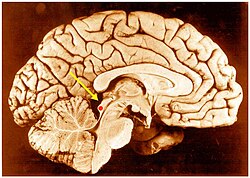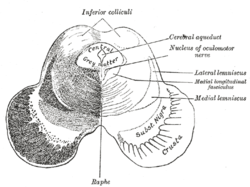| Inferior colliculus | |
|---|---|
 Inferior colliculus (red dot) in human brain, sagittal section. | |
 Transverse section of mid-brain at level of inferior colliculi | |
| Details | |
| Part of | Tectum |
| System | Auditory system |
| Identifiers | |
| Latin | colliculus inferior |
| MeSH | D007245 |
| NeuroNames | 476 |
| NeuroLex ID | birnlex_806 |
| TA98 | A14.1.06.014 |
| TA2 | 5916 |
| FMA | 62404 |
| Anatomical terms of neuroanatomy | |
The inferior colliculus (IC) (Latin for lower hill) is the principal midbrain nucleus of the auditory pathway and receives input from several peripheral brainstem nuclei in the auditory pathway, as well as inputs from the auditory cortex.[1] The inferior colliculus has three subdivisions: the central nucleus, a dorsal cortex by which it is surrounded, and an external cortex which is located laterally.[1] Its bimodal neurons are implicated in auditory-somatosensory interaction, receiving projections from somatosensory nuclei. This multisensory integration may underlie a filtering of self-effected sounds from vocalization, chewing, or respiration activities.[1]
The inferior colliculi together with the superior colliculi form the eminences of the corpora quadrigemina, and also part of the midbrain tectum. The inferior colliculus lies caudal to its counterpart - the superior colliculus - above the trochlear nerve, and at the base of the projection of the medial geniculate nucleus and the lateral geniculate nucleus.